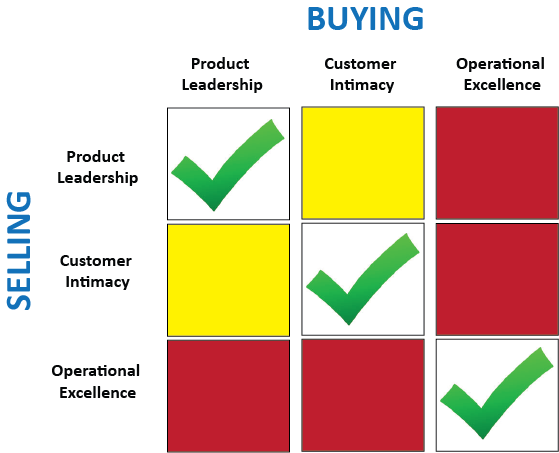A business organization is only successful if it can deliver a clear and powerful value proposition to its customers. Whether you follow the strategic frameworks of Michael Porter, Michael Tracey & Fred Wersema, or Clay Christensen, they all lead to one conclusion; the most successful organizations in the world are able to empower its leaders and individual contributors to align and execute on a strategy that sells a value proposition that is a unique bundle of price, quality, service, marketing, and other factors that prompt customers to buy.
customers. Whether you follow the strategic frameworks of Michael Porter, Michael Tracey & Fred Wersema, or Clay Christensen, they all lead to one conclusion; the most successful organizations in the world are able to empower its leaders and individual contributors to align and execute on a strategy that sells a value proposition that is a unique bundle of price, quality, service, marketing, and other factors that prompt customers to buy.
There are many examples of great business ideas that have failed due to poor execution and many bad business ideas that somehow were successful because they were able to execute a plan well in markets that had weak completion or misaligned value propositions. Inevitably, most business organizations will choose one of three different value propositions. Consider these best-in-class companies:
- Apple – is one of the best in the world at delivering on the value proposition of Product Leadership
- The Ritz-Carlton – is one of the best in the world at delivering on the value proposition of Customer Intimacy
- Walmart – is one of the best in the world at driving costs out of their system so they can offer the lowest possible price
This concept of selling a unique value proposition to customers is a core part of Advantexe’s Business Simulation-Centric Business Acumen learning journeys. In the learning journeys, we focus on the skills and tools needed by leaders to understand strategic thinking and then measure the effectiveness of their strategic execution through financial metrics and performance.
During a recent project, one of my very bright participants asked one of the most interesting questions I’ve ever heard, “What are the consequences to a business if you try to sell your value proposition to customers who want or expect a different value proposition?
Based on this question, I created this graphic that presents Selling Organizations, Customer Segment desires, and the consequences of selling across the value proposition.

What can we learn?
Sell to the Right Customers
The first thing we learn is that the easiest and most profitable thing to do is sell your value proposition to customers who are expecting and want the same value proposition (represented by the green check marks). In other words, if you are Apple, then sell to customers who want the most innovative product in the market.
The next thing we learn is the interesting relationship and consequences of Customer Intimacy and Product Leadership (represented by the yellow boxes). Yellow represents caution and mild effectiveness and business sustainability.
Selling Customer Intimacy to Customers expecting Product Leadership
This is actually a common scenario for organizations that don’t have Product Leadership. What they lack in product innovation and quality they try to make up in service and attention to customers. It will work for a short amount of time if there are not 2-3 significant Product Leadership players in the market. However, as new Product Leaders enter, the harder it is to maintain share and profitability.
Selling Product Leadership to Customers expecting Customer Intimacy
This is a common scenario for organizations trying to capture early share with a new product launch. The general strategy is to overwhelm customers with bells, whistles, and marketing driving customers who want customer intimacy to still make a purchase despite the fact they are not getting the service and customization they really want. This approach is also a short-term approach as pure customer intimate players will soon enter the market.
Selling or Receiving anything other than Operations Excellence (Low Price)
The third scenario is the most distinct and has the most immediate consequences. Basically if you are selling Operational Excellence (a lower quality, low price product) then the only customer who you should focus on – and who will buy – are customers who want that value proposition. At the same time, if you are a customer looking for the lowest possible price, you are going to reject higher priced products that offer expensive quality or extra and expensive services.
In summary, no company today be all things to all people; you can’t offer the most innovation, the most service, and be competitive on price. It won’t work and it’s not sustainable. By crossing over the value proposition lines, there are great and unrecognized consequences. Hopefully, this blog and participation in Business Acumen learning can help you avoid those mistakes.




